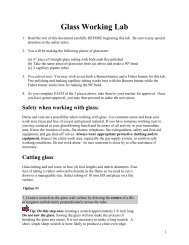Chapter 15: Solutions - Weironline.net
Chapter 15: Solutions - Weironline.net
Chapter 15: Solutions - Weironline.net
You also want an ePaper? Increase the reach of your titles
YUMPU automatically turns print PDFs into web optimized ePapers that Google loves.
a b c<br />
Figure <strong>15</strong>-13<br />
Accurately preparing a solution<br />
takes care. a In step 1, the mass<br />
of solute to be used is measured<br />
out. b In step 2, the solute is<br />
placed in a volumetric flask of<br />
the correct volume. c In step 3,<br />
distilled water is added to the<br />
flask to bring the solution level<br />
up to the calibration mark on<br />
the flask.<br />
Practice!<br />
For more practice with<br />
molarity problems, go<br />
to Supplemental<br />
Practice Problems in<br />
Appendix A.<br />
466 <strong>Chapter</strong> <strong>15</strong> <strong>Solutions</strong><br />
Preparing Molar <strong>Solutions</strong><br />
Now that you know how to calculate the molarity of a solution, how do you<br />
think you would prepare 1 L of a 1.50M aqueous solution of sucrose<br />
(C 12 H 22 O 11 ) for an experiment? A 1.50M aqueous solution of sucrose contains<br />
1.50 moles of sucrose dissolved in a liter of solution. The molar mass<br />
of sucrose is 342 g. Thus, 1.50 moles of sucrose has a mass of 513 g, an<br />
amount that you can measure on a balance.<br />
��<br />
1.50 mol<br />
C12H22<br />
1 L solution<br />
O11 � �� 342<br />
g C12H22O<br />
1<br />
� ��<br />
1 mol<br />
C H O<br />
513 g C12H22<br />
1 L solutio<br />
O11<br />
�<br />
n<br />
Unfortunately, you cannot simply add 513 g of sugar to one liter of water<br />
to make the 1.50M solution. Do you know why? Like all substances, sugar<br />
takes up space and will add volume to the solution. Therefore, you must use<br />
slightly less than one liter of water to make one liter of solution. Follow the<br />
steps shown in Figure <strong>15</strong>-13 to learn how to prepare the correct volume of<br />
the solution.<br />
You often will do experiments that call for only small quantities of solution.<br />
For example, you may need only 100 mL of a 1.50M sucrose solution<br />
for an experiment. How do you determine the amount of sucrose to use? Look<br />
again at the definition of molarity. As calculated above, 1.50M solution of<br />
sucrose contains 1.50 mol of sucrose per one liter of solution. Therefore, one<br />
liter of solution contains 513 g of sucrose.<br />
This relationship can be used as a conversion factor to calculate how much<br />
solute you need for your experiment.<br />
100 mL � �<br />
1 L<br />
� ��<br />
1000<br />
mL<br />
513<br />
gC12H22O11<br />
� � 51.3 g C<br />
1 L solution<br />
12H22O11 Thus, you would need to measure out 51.3 g of sucrose to make 100 mL of<br />
a 1.50M solution.<br />
PRACTICE PROBLEMS<br />
17. How many grams of CaCl 2 would be dissolved in 1.0 L of a 0.10M<br />
solution of CaCl 2 ?<br />
18. A liter of 2M NaOH solution contains how many grams of NaOH?<br />
19. How many grams of CaCl 2 should be dissolved in 500.0 mL of water<br />
to make a 0.20M solution of CaCl 2 ?<br />
20. How many grams of NaOH are in 250 mL of a 3.0M NaOH solution?<br />
12<br />
22<br />
11




